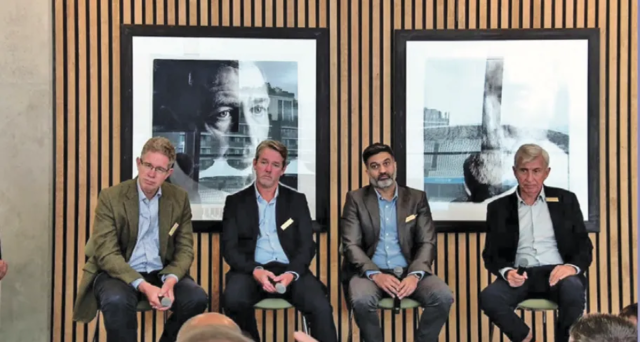Srinagar, Oct 14: In a historic first, the Kashmir Willow Manufacturers Association, led by GR-8 Sports, was invited by the Marylebone Cricket Club (MCC) – a world-famous club that owns Lord’s Cricket Ground that is known as the ‘Home of Cricket’ – and supported by the International Cricket Council (ICC), the global governing body for cricket, to participate in an international conference at Lord’s Cricket Ground, London, focused on the future of cricket bats and the sustainability of willow wood.
The global Cricket Bat Conference brought together leading cricket bat, ball, and equipment manufacturers, including Kookaburra, Duke, SG India, CA Pakistan, Gray-Nicolls (GM), and JS Wright and Sons.
Representing India and the Kashmir willow industry, GR-8 Sports made a strong case for recognising Kashmiri willow as a sustainable, high-quality alternative to English willow – the traditional material used in cricket bats.
“It’s the first time in history that MCC and ICC recognised the Kashmir willow industry and took us into confidence,” said Fawzul Kabir, co-founder of Kabir Brothers – GR-8 Sports. “We were asked to contribute to discussions on how to protect both English and Kashmiri willow and ensure the game doesn’t lose its most essential tool, the bat.”
The conference addressed growing concerns about the future of bat-making as both English and Kashmiri willows face environmental threats, including deforestation, declining cultivation, and the effects of climate change.
“The question was: What happens to cricket when the willow disappears?” Kabir said. “Should we amend bat regulations, explore laminated substitutes, or double down on sustainable cultivation? These are decisions that will shape the game’s future.”
Kabir presented the case for Kashmir willow as a viable, eco-friendly, and affordable substitute for English willow, highlighting advances in manufacturing and treatment techniques that have reduced weight and enhanced fiber strength.
“For decades, English willow was considered superior for being lighter,” Kabir said. “But over the past few years, we’ve refined our processes using AI-based seasoning chambers that reduce moisture from 30 percent to 10 percent without harming fiber strength. Today, Kashmir willow bats can compete at any level of the game.”
Kabir credited Walter Lawrence and Macdowell, two British officers posted in Kashmir during the colonial era, for introducing willow plantations to the Valley more than a century ago.
“We owe gratitude to the British for planting the first willows in Kashmir,” he said. “They created an industry that now sustains thousands of families and continues to serve world cricket.”
The Kashmir willow industry today is valued at over Rs 700 crore, employing over 10,000 workers across 400 manufacturing units in south Kashmir.
Around 220 units are concentrated in Bijbehara, Sangam, and Halmulah in Anantnag district, while another 180 units operate in Awantipora, Pulwama’s Pujteng, Sethar Charsoo, and Jawbara villages.
The region collectively produces over 30 lakh bats annually, providing livelihoods to nearly 1.5 lakh people, including woodcutters, craftsmen, polishers, and exporters.
Kabir, said he planted 15,000 willow saplings in the past four years and urged governments and cricket boards to include willow in reforestation drives.
“The world talks about global warming and climate change,” he said. “Why not make a willow plantation part of that conversation? If we lose willow, cricket as we know it will change forever.”
He also revealed that modern Kashmiri bats are now made from the same female white willow species (Salix alba var. caerulea) used in England, cultivated under scientific supervision in collaboration with Sher-e-Kashmir University of Agricultural Sciences and Technology (SKUAST) and the J&K Forest Department.
“Earlier, we used mixed willow varieties, which made the bats heavier,” Kabir said. “Now, through selective breeding and controlled processing, we’ve matched English willow even at the atomic and tissue level.”
The MCC and ICC delegates acknowledged the evolution of Kashmir’s bat industry and its growing global relevance.
“They recognised that Kashmiri willows can stand shoulder-to-shoulder with English willow – with certain refinements,” Kabir said. “They appreciated our work and assured full advocacy at MCC, ICC, and BCCI levels.”
GR-8 Sports, which has already supplied bats used in five ICC World Cups, was lauded for maintaining high quality and innovation.
According to Kabir, the ICC had earlier scanned GR-8 bats and rated them among the best-performing bats globally.
The Lord’s conference was attended by representatives from Australia, New Zealand, the West Indies, South Africa, India, Pakistan, England, Sri Lanka, and Bangladesh, along with manufacturers, environmental scientists, and cricket board delegates.
The participants unanimously agreed on a global plan to conserve willow plantations and passed a resolution to involve the United Nations and climate-focused organisations in protecting the species crucial to cricket’s future.
“MCC and ICC assured unwavering support to our cause,” Kabir said. “They told us: ‘You have been the pioneers of advocating for Kashmiri willow. Take it forward, and we’ll stand by you.’”
The meeting ended with a joint pledge that summed up the mood at Lord’s: “Willow must be saved to preserve cricket’s legacy.”








